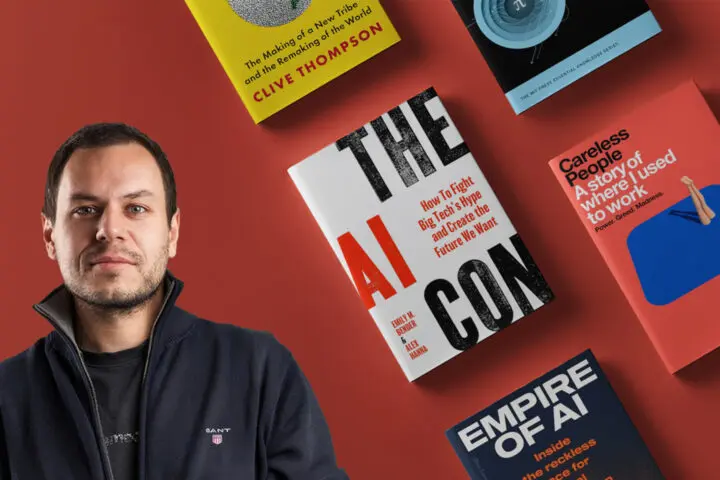The perfect 5 step recipe for a delightful copywriting cake. Because you CAN have your cake and eat it too!
With development of internet and new media, the need for creative people called ’copywriters’ arose like a phoenix. Their job is to create and shape the message, through the process of analyzing and planning creative ideas and content for different types of platforms and purposes. That includes web pages, social media, mobile applications and much more. In that process (1:M) there are a couple of elements which we need to consider when creating and shaping content for digital platforms and mass audience on that platform.
In the last 10-15 years a lot has changed in the realm of digital communication and content creation. From simple static pages and limited content such as photos, videos and text, to today’s wide variety of forms of dynamic and interactive content which we use to communicate with a targeted audience, clients and the public. Back then the most important thing was to have a website and be visible and reachable to your public or potential clients. Today, web pages and digital content that we publish have expanded their function. It’s being used not just for communication, but for creating and shaping the identity and story behind every successful business or brand.
At the same time, with the development of the internet and new media, the need for creative people called ’copywriters’ arose like a phoenix. Their job is to create and shape the message, through the process of analyzing and planning creative ideas and content for different types of platforms and purposes. That includes web pages, social media, mobile applications and much more. Today, everything we post on the internet is a message in the process of mass communication. Mass communication persuades or influences the behavior, attitude, opinion, or emotion of the person or group of people receiving the information. It’s the process by which a person, group of people, or large organization creates a message and transmits it through some type of medium to a large, anonymous, heterogeneous audience. It implies that the audience of mass communication is mostly made up of different cultures, behaviors and belief systems. Mass communication is regularly associated with media influence or media effects. In that process (1:M) there are a couple of elements that we need to consider when creating and shaping content for digital platforms and mass audiences on that platform.
For our perfect chocolate copywriting cake we’ll need 5 ingredients: Eggs, sugar, flour, butter and lots of chocolate. In other words, we’ll need the message, content, channel, receiver and effect of a copy.

Who? (Who is sending the message?) [Eggs]
The subject who originates a message is the sender or communicator. A sender puts a message in a channel (medium) that delivers the message to the receiver. Usually, when it comes to mass communication on the digital platforms sender can be anyone with access to the internet. It can be one individual person or a whole company as a business entity. In either way, the communicator is the information source that shapes and produces a message to the clients and the public. He has the power to give a specific meaning to the message and to direct the content and the meaning of the message to his own accordance. For business subjects, proactive communication is important for maintaining a positive relationship between them and their targeted audience, existing clients, or potential clients. Even more important is the necessity to constantly maintain proactive communication and expand the influence or visibility of the business or brand. In today’s business world, no one can be in isolation from communication with different types of audiences and the public.
Behind every message, there should be a reason or intention for sending it. Sometimes it’s sent for the purpose of informing and sending new information about products, services, or any other new aspect of the business. In most cases, the need for communication is based on building long-term relationships between the business subject and their public or other stakeholders. Other than informing, communication is important to extend the reach and visibility of a business subject or brand. Where are the copywriters in this context? Copywriters are one of the most important parts of communication because they analyze the existing situation, create an idea for the content and shape it to meet the needs of the business subject and their targeted public.
Say’s WHAT? (Message) [Sugar]
Usually when somebody says ‘’message’’ a large part of people think that is some kind of text in standard, traditional written form. In a digital environment messages can be anything and in any form that has meaningful significance. It can be text, picture, emoji, video, web page, infographic, gif, or any form that has meaning for us or our public. For instance, everything on a web page is the message, even the webpage itself is a part of a broader message. From the text, pictures, and infographics to the design to other various elements on the page. Every element separately tells a small piece of a bigger story behind the business subject or brand. In other words, the message is all elements that give us some kind of impression, information or meaning. The design of a page is certainly the most visible form of a message. It should reflect an impression of who we are, what we do, on what principles and policies a business subject or brand functions. Most importantly it answers the question: of how people will perceive a business subject or brand. What kind of image will they create about someone or something?
For a copywriter, creating a message is a whole different story. It includes taking into consideration various elements of the business subject or brand which needs to be incorporated into the message. These elements usually are brand identity, mission, vision, goal, or some piece of new information that is important to customers or the public. First of all, a good copywriter must analyze the current situation of the identity and public image of a business or brand. Their strengths and weaknesses, leverages and things by which they differ from others. This is an important step to evaluate the current situation and to get a better view of important features and elements which we need to be included in the message. Besides that, the message must contain valuable information for the receiver and it should have an ‘’attention-grabbing’’ or ‘’eye-catching’’ component.
What does that mean?
It means that the form of the message must be adapted to the digital environment. This implies that we can use different forms of content separately or together to form a coherent and holistic message. That message must be unique, and catchy and recipients must understand the meaning. In other words, when creating and planning such content, the copywriter must think about desire and understand the meaning of the message. It also means that a copywriter must create exclusive ideas or content which nobody has used before or thought of. The content should be appealing, interactive, and unique, and most of all, well-adapted to the target audience. In other words, we must understand for who are we creating the message, how will they perceive it and as an end result, whether will they understand the message and engage.
CHANNEL – MEDIUM [Butter]
The channel or medium through which we send a message is important as the message itself. The copywriter must consider the medium when it comes to planning and shaping a message. In the era of digital technology, the internet and new media are the easiest and quickest way to reach a large group of people in one ‘’place’’. Electronic communication technology lessens the distance by reducing the time it takes to send or receive a message. Modern media expands our ability to perceive the world around us and gather information. Users deliberately choose media that will satisfy given needs and allow them to enhance knowledge, relaxation, social interactions-companionship, diversion, or escape. In other words, users have a voluntaristic and selective orientation toward the communication process and consuming media content. It suggests that media use is motivated by needs and goals that are defined by audience members themselves and their lifestyles or preferences.
Unlike traditional media such as radio, television, or newspapers, the internet and digital media are instant channels or way to find information or content to which the audience wants to be exposed. They can actively choose the sort of content that they want to consume, when and where they want to consume it, and for how long. For example, on traditional media channels, the user has minimal options for choosing which type of content he wants to be exposed. He can choose from different programs, stations or broadcasters, but he can’t pick the type of content. This results in traditional, linear content. It’s broadcasted by schedule and adapted by everyday routine and flow. Since more and more people are becoming online-focused, the internet has become an imperative in communication and marketing. New media is increasing the speed of information flow and changing the way how we send and receive messages and content. Marketers can use online media to better reach their target audience. Once marketers understand the segments of their target market, they can generate a marketing message suitable for the intended target audience. Communicating to consumers through tools such as web banners, social media and e-mails, allows direct customer targeting.
Furthermore, new media platforms are usually the cheapest way to maintain continuous communication and relationship with clients and the public. Messages that we send online and the way we shape them sometimes have a powerful impact on different business segments in the context of ROI. Not only are they viral and highly visible, they also have a broad reach to the dispersed public. If the content is creative, unique and interactive, it’s more likely to better serve its purpose and have a greater impact on the public. Considering that it’s important to be up to date with new content forms and capabilities which new media is offering. Social media such as Twitter, YouTube and Facebook allow two-way communication between the business and consumer, which cannot be achieved by traditional media. This communication benefits both the business utilizing social media as a tool and the consumer as they can build meaningful relationships with the business and other consumers, creating a community surrounding the brand.
TO WHOM? – Receiver [Flour]
In the context of mass media and communications, we are all part of the public. Not just on the internet or new media. Most of the time we are all active participants in mass communication, whether we realize it or not. For instance, every billboard, advert or screen on the street around us is some kind of a message. Even if we don’t pay attention, we consume media content every day through our environment. Most big cities are mediated and filled with media content and messages which are strategically located on places where lots of people gather and fluctuate. Digital media are not so different in the context of exposure to media and messages that they send. They gather a very large number of members, also known as a divergent (heterogeneous) public in just one ‘’place’’.
That place is not geographically defined, but it is defined by them as a public, their interests and content that they want to be exposed to. They choose the content which they want to consume on their interests, lifestyle or need. Before sending a message, a copywriter must think of the target audience to which he wants to communicate and send a message. That kind of public is called the targeted audience. A targeted audience is the intended audience or readership of a publication, advertisement, or other type of message. In marketing and advertising, it is a particular group of consumers within the predetermined target market, identified as the targets or recipients of a particular message. The targeted audience is more specific than the divergent or divergent public because they share common points of interest. Reaching a target audience is a staged process, starting with the selection of the sector of the target market.
A successful appeal to a target audience requires a detailed media plan, which involves many factors in order to achieve an effective campaign. In this process, we must take in consideration various elements and factors which can help us narrow down the scope of the audience. The target audience is often segregated by factors or elements such as demographic and psychographic differences. The audience within these target segments can have different regional, ethnic, lifestyle, and monetary and religious requirements. We can target them by their demographic information (gender, ethnicity, income or marital status), psychographic information (lifestyle, interests, hobbies), behavioral information (what influences their purchase decision- behavior trends) and geographic information (location, resources, cultures, climate etc.)
After a thorough analysis of the targeted audience, the process of message shaping begins. For a copywriter that is the hardest part in which he or she has to be able to distinguish important elements and factors which need to be incorporated in the message. As our targeted public is the receiver in the communication process, they are the ones that decode the message we sent them. They interpret the message and its meaning at their own discretion and choice. Behind that interpretation, there are numerous variables which a copywriter should consider when planning and shaping a content or message. Some of them are their previous experience, environment, habitus or society they live in. All that is important to consider in the process of copywriting and content planning.
WITH WHAT EFFECT? [Chocolate!]
Every campaign or activity which was intended to send information or trigger some kind of reaction has a measurable effect. Digital media are a lot different than traditional media. Nowadays there are numerous ways to analyze the impact of a message. What methods are a lot simpler and more efficient than traditional media such as television, radio, or publishing. On digital media and the internet, there are two main distinctions in the ponderability effect of our message or campaign.
The first one is NON-PROFIT IMPACT – Nonprofit or nonfinancial impact has all the factors like an increase in unique website visitors, the volume of impressions, comments on blog posts, followers on social media, or newsletter subscribers. It also includes mentions in the press and other channels which increase the visibility and reach of our message or brand. These kinds of factors are important for creating a positive image, establishing communication and most importantly the end result which should be creating a long-term relationship with clients, customers and the public.
PROFIT IMPACT – Profit impact is more measurable and visible than nonprofit impact because it’s the direct indicator or a result of the message.
We can measure it by:
FREQUENCY – How often have customers made a transaction? (transactions per month)- This includes analysis of transactions in the time period after we sent our message or started our campaign. It allows you to compare before and after results.
REACH – How many customers are you reaching? (new customers)- New customers are easy to identify because they usually bring growth in product demand or increase revenue in business.
YIELD – How much they spend ($ per transaction) – Increase in revenue is a visible factor on how much are new customers and clients spending and is there any change in transaction amount?







